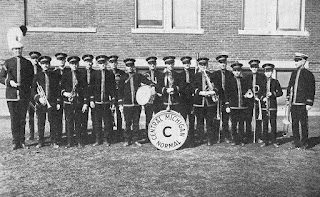by Arianna Day
Dr. Lloyd McGee Cofer—the name might be familiar around the Central Michigan University campus. As we wrap up Black History Month and reflect on the 60th anniversary of the first meeting of the CMU Board of Trustees, we share more about this leader who helped shape CMU for nearly two decades.
Dr. Cofer was born in New York, New York, December 18, 1905. He went to college at Tufts College during the fall of 1924. While he was there, he joined Alpha Phi Alpha, the oldest African American Greek letter fraternity in the U.S.
Dr. Cofer graduated from Tufts in 1928 with his Bachelor of Science degree and then served as the Dean of Men as Fisk University from 1930-34. In 1934, he was hired in the Detroit public schools, becoming the first Black man to be a counselor in Detroit school system. Later, Dr. Cofer served as assistant principal of two different schools and, in 1965, he became Principal at Mackenzie High School. During his more than 30-year tenure with the Detroit public schools, he earned
his master’s degree at Columbia University and his doctorate degree at Wayne State University.
Dr. Cofer left the Detroit Public Schools in 1967 to work at Michigan State University, where he served in many capacities focused on increasing the recruitment and retention of Black students until his retirement in 1979. At MSU, he created a development program as well as special services for minority students at MSU (MSU News May 27, 1971, p. 6).
 |
| Dr. Lloyd M. Cofer at the first CMU Board of Trustees Meeting, February 24, 1964 |
For Central Michigan University, Dr. Cofer is most well-known as a charter member of the Board of Trustees and the namesake of a long-standing scholarship for Central students. On the 60th anniversary of the first meeting of Central Michigan University’s Board of Trustees, we recognize Dr. Cofer’s contributions to the Board.
In February 1964, Dr. Cofer was among the first group of eight who was appointed by Michigan Governor George Romney to CMU’s newly formed Board of Trustees. Joining him on this group that met for the first time on February 24, 1964 were Jean Backus, Willis Campbell, Katharine Hafsted, Lawrence Rahilly, E. Allan Morrow, John Sivier, and Walter Wightman.
During his 17 years of service on the Board of Trustees, Dr. Cofer was elected chair three times, the first time being in 1967, just three years after his initial appointment. Among the major changes that Dr. Cofer oversaw as a Trustee, Cofer was the Chair of the Board that approved Amendment V to the Student Bill of Rights and Responsibilities, which abolished the practice of in loco parentis. Cofer supported the students in their efforts to assert their rights and to demand that the university stop acting “in place of the parents” and monitoring students' behavior.
Many other developments and progress occurred during his 17 years on the Board including:
- CMU moving up to Division I in NCAA competition,
- CMU beginning an effort to increase the recruitment of Black faculty and Black students, as well as teaching Black studies courses,
- CMU constructing many new buildings (the Towers, the Park Library, the North Art Studio, Anspach, Pearce, and Moore Halls, and much more),
- and the beginnings of labor negotiations between the university and the Faculty Association.
Outside of education and higher learning, Dr Cofer found the love of his life in Evelynne J Jones. Together, they had two daughters and they remained married until her death in 1972.
Dr. Cofer was always devoted to students, working up to the time of his death on January 11, 1980. In death, he was remembered for his contributions to education in Michigan and across the U.S. Rev. Malcolm G. Dade of St. Cyprian said of Dr. Cofer, “Lloyd never went for a job; every position sought him.” Horace C. King, MSU Registrar and Professor, said, “[Dr. Cofer] influenced higher education not only in the state of Michigan but also on a national level.”
Two weeks after the passing of Dr. Lloyd M. Cofer, the CMU Board of Trustees established the Lloyd M. Cofer scholarship. Created in 1980 in his memory, the scholarship provided for full tuition and fees awarded to a deserving student who is the graduate of a public high school of the city of Detroit. The scholarship still exists and today and "recognizes a select few Detroit high school graduates
for their dedication to the advancement of underrepresented groups in
America."










